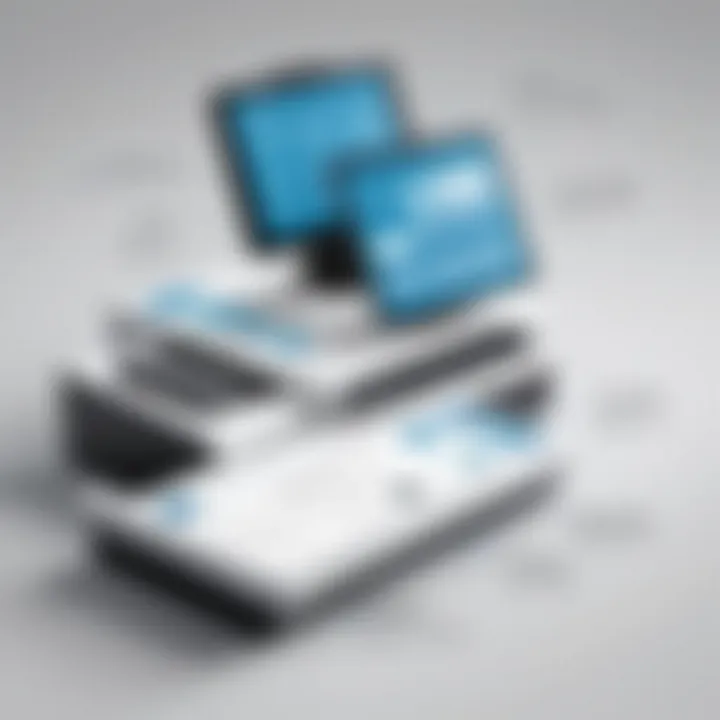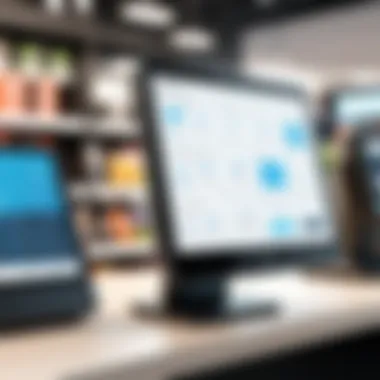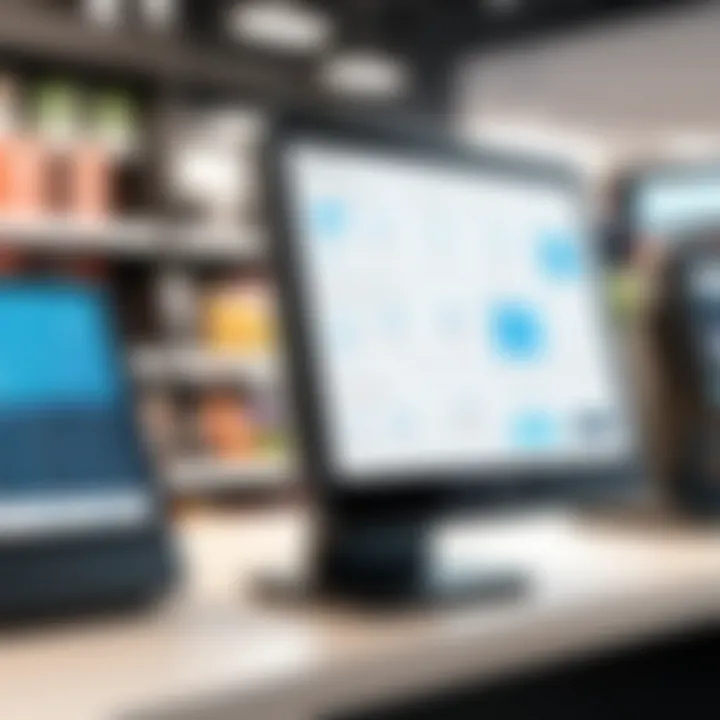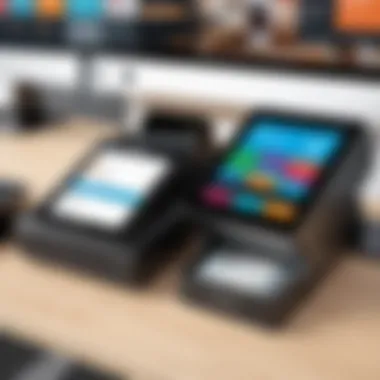Understanding POS Applications: A Comprehensive Overview


Intro
Point-of-sale (POS) applications have transformed the way businesses conduct transactions in modern retail and service environments. With the evolution of technology, these systems have become central to operational management, enabling companies to streamline processes, enhance customer experiences, and improve overall efficiency. The purpose of this guide is to delve into the different aspects of POS applications, providing decision-makers and IT professionals with the necessary insights to make informed software choices. By evaluating functionalities, comparative performance against competitors, and pricing structures, stakeholders can align the right POS solutions with specific business needs.
Software Overview
Brief Description of Software
POS applications serve as a critical interface for processing sales transactions in various industries. They typically integrate hardware, such as touchscreens and card readers, with software that handles sales data, inventory, and customer management. The software acts as the brains of the operation, allowing users to conduct sales efficiently while managing comprehensive aspects of the business.
Key Features and Functionalities
A powerful POS application encompasses several essential features and functionalities:
- Sales Processing: Quickly handle transactions, including cash, credit, and mobile payments.
- Inventory Management: Track stock levels in real-time, set reorder alerts, and manage supplier information.
- Customer Relationship Management (CRM): Maintain customer records, purchase history, and preferences to tailor marketing efforts.
- Analytics and Reporting: Generate detailed reports on sales trends, employee performance, and inventory turnover for data-driven decision-making.
- Integration Capabilities: Seamlessly connect with other business systems, such as accounting software and e-commerce platforms.
Detailed Comparison
Comparison with Competitors
In a competitive landscape, various POS applications vie for market share. Understanding how a specific software stacks up against others can help businesses make the right choice. For instance, Square provides a user-friendly interface with no monthly fees, while Shopify POS offers robust e-commerce integration for retail businesses. Evaluating customer reviews, support responsiveness, and system flexibility is crucial for determining the best fit.
Pricing Structure
Pricing models vary significantly between POS software products. Some operate on a subscription basis, while others require a one-time purchase. A breakdown of typical pricing structures includes:
- Monthly Subscription: Ranges from $0 to $300, depending on features and support.
- One-Time Purchase: Often between $1,000 to $5,000, with additional fees for updates and support.
- Transaction Fees: Typically ranges from 1.5% to 3.5% per transaction, affecting overall cost depending on sales volume.
Analysis of costs and returns on investment (ROI) is vital when considering a POS solution.
In summary, understanding the landscape of POS applications allows decision-makers to identify the most suitable software for their business needs. This exploration will serve as a foundation for future discussions on specific functionality, potential benefits, and user experiences.
Defining POS Application
Defining a POS application involves understanding its essential role in modern retail and service environments. As businesses increasingly rely on technology to streamline operations, POS systems become integral. They encapsulate not just the ability to process sales but also to manage various business functions in a cohesive system. This section aims to clarify what constitutes a POS application and highlight its critical features.
What Constitutes a POS Application?
A POS application is a software solution designed to facilitate sales transactions. However, its scope goes beyond mere sales processing. A comprehensive POS system integrates various functionalities to enhance overall efficiency. These functionalities often include sales tracking, inventory management, and customer interaction. It is a tool that connects different aspects of a business into a unified interface smoothly. This unified operation is essential for providing quality customer service while simultaneously improving internal processes.
Key Features of POS Applications
Key features make POS applications invaluable for businesses of all sizes. By evaluating these features, decision-makers can better understand how they contribute to operational effectiveness and customer satisfaction.
Sales Tracking
Sales tracking refers to the ability of a POS application to monitor and record sales data in real-time. This feature allows business owners to see which products sell well and which ones do not. Accurate sales tracking is fundamental for establishing trends and predicting future inventory needs. Additionally, it enables data-driven decision-making, which is crucial in optimizing sales strategies. Without effective sales tracking, businesses risk losses due to overstocking or understocking products.
Inventory Management
Inventory management is the function within a POS application that oversees stock levels, orders, and deliveries. This feature ensures that businesses can maintain optimal stock levels to meet customer demand. Effective inventory management reduces waste and prevents stockouts. A unique aspect is the ability to set reorder points, which alerts users when stock levels reach a critical threshold. This proactive measure helps maintain seamless operations and customer satisfaction.
Payment Processing
Payment processing is a vital function of any POS application. It handles various payment methods, including credit cards, debit cards, and mobile wallets. The ability to accept multiple forms of payment enhances customer convenience. Additionally, secure payment processing mitigates the risk of fraud and builds customer trust. A notable feature is the integration of payment processors that support multiple currencies and transaction types. This aspect broadens market accessibility, which is beneficial for businesses operating in diverse environments.
Customer Management


Customer management is a critical feature that enables businesses to manage interactions and data related to customers effectively. It supports building customer profiles that include purchase history, preferences, and contact information. This feature is instrumental in creating targeted marketing campaigns and improving customer loyalty. The ability to segment customers based on their buying behavior allows businesses to tailor their offerings, ultimately enhancing the customer experience.
"A robust POS application not only processes transactions but also integrates an array of functions that elevate customer interaction and operational efficiency."
Overall, defining POS applications requires an exploration of their multi-faceted functionalities. Each key feature plays a role in enhancing operational efficiency and improving the customer experience.
Types of POS Applications
Understanding the different types of point-of-sale applications is crucial for businesses aiming to optimize their operations. Each type of POS system brings unique benefits and considerations that can significantly affect customer experiences and overall efficiency. The choice of POS application often depends on specific business needs, operational scale, and technological infrastructure. Here are the main types of POS applications:
Traditional POS Systems
Traditional POS systems usually consist of hardware and software solutions installed on-site. These systems are commonly found in retail stores and restaurants. They require constant internet access to function properly and often come with high initial costs.
Some important features of traditional systems include:
- Stability: They can operate offline, which is beneficial during internet outages.
- Comprehensive Functionality: These systems often provide solid features for sales tracking, payment processing, and inventory management.
- Hardware Integration: Easily integrates with scales, printers, and barcode scanners.
Despite their certain advantages, traditional systems can present challenges, such as limited flexibility and higher maintenance requirements. Business may need to contend with costly updates and hardware replacements over time.
Cloud-Based POS Solutions
Cloud-based POS solutions have recently gained popularity among various businesses. These systems operate on the internet, allowing users to access their information from anywhere with a compatible device. They usually follow a subscription model, which can be more financially feasible for many businesses.
Key advantages of cloud-based systems include:
- Real-Time Data Access: Users can obtain insights and analytics immediately.
- Cost-Effectiveness: Lower upfront costs and predictable ongoing expenses.
- Automatic Updates: Software updates happen seamlessly without user intervention.
However, businesses must ensure they have a stable internet connection to utilize these systems effectively, as their performance depends heavily on connectivity.
Mobile POS Applications
Mobile POS applications have transformed how businesses interact with customers. These applications run on mobile devices such as tablets or smartphones, facilitating transactions at any location. This flexibility makes them particularly appealing for businesses in the service sector, like food trucks and pop-up shops.
Benefits of mobile POS include:
- Portability: Employees can process payments anywhere on the premises.
- Enhanced Customer Experience: Customers appreciate quick and efficient service.
- Integration with Payment Options: These applications can often accept various payment methods, including contactless payments.
The challenges with mobile POS may involve security concerns and reliance on device battery life.
Self-Service Kiosks
Self-service kiosks are becoming increasingly prevalent in various industries, including fast food, retail, and healthcare. They enable customers to complete transactions independently.
Considerations for self-service kiosks include:
- Efficiency: Reduces wait times and enables customers to serve themselves.
- Cost Savings: Decreases labor costs as fewer employees are needed for service.
- Customization Options: Often allows for personalized ordering experiences.
However, implementation can require significant upfront investment and necessitates careful planning to ensure a user-friendly interface.
In summary, selecting the right POS application type is essential for operational success. Each option provides distinct advantages and potential drawbacks that business decision-makers must carefully evaluate.
The Role of POS Applications in Business Operations
Point-of-sale applications are not merely tools for processing transactions. They play a pivotal role in the overall operation of businesses, especially in retail and service sectors. These applications are integral in shaping how businesses interact with customers, manage inventories, and analyze their performance.
Employing an effective POS application can transform many aspects of business operations. This transformation leads to improved customer satisfaction and streamlined internal processes. In an era where customer expectations are high, ensuring a positive experience is necessary for retaining clientele.
Enhancing Customer Experience


The customer experience is paramount for any business aiming to thrive. POS applications contribute significantly to this by facilitating faster transactions and reducing wait times. Customers prefer an efficient point-of-sale process. Features like contactless payments and mobile checkout are increasingly sought after. Customers enjoy a seamless buying experience without the stress of long queues.
Moreover, a POS application can store customer data, thus enabling personalized service. This includes tailored promotions or recommendations based on purchase history. When businesses adopt a customer-centric approach, they can boost loyalty and increase sales.
"Investing in POS applications means investing in customer satisfaction. A well-implemented system speaks volumes about a brand's dedication to service."
Improving Operational Efficiency
Operational efficiency is vital for sustaining long-term success. A robust POS application accomplishes this by automating several processes. Inventory management, sales tracking, and reporting become smoother and less prone to error. When staff spend less time on manual tasks, they can focus on high-value activities that enhance productivity.
Additionally, integration with other business systems, such as accounting software, helps streamline operations. Employees benefit from real-time data, leading to informed decisions and optimal resource allocation. This reduces delays and enhances the supply chain's overall agility.
With precise data at their fingertips, decision-makers can also quickly adapt to market changes. Efficient operations can facilitate better customer service, increasing the chances of repeat business.
Data Analytics and Insights
In today's data-driven world, the ability to analyze business performance is essential. POS applications provide critical insights through sales data and inventory levels. Such analytics can help businesses identify trends, monitor performance, and predict customer behavior.
By leveraging these insights, businesses can refine their strategies and identify growth areas. For instance, knowing which products are bestsellers allows for better inventory management. This prevents stockouts and overstock situations, maintaining a well-balanced supply.
Furthermore, tools that support data visualization make it easier to comprehend complex information. Business stakeholders can measure key performance indicators, facilitating strategic planning and operational adjustments. This analytical capability is crucial in a competitive landscape where informed decisions lead to better outcomes.
Selecting a POS Application
Choosing the right point-of-sale application is a critical step for any business that intends to enhance transaction processes, streamline operations, and ultimately improve the customer experience. Your choice of POS system can significantly influence not only the efficiency of daily operations but also data management and customer interactions. A well-selected POS application aligns with your business goals, caters to specific needs, and supports long-term growth.
Identifying Business Needs
Understanding the unique needs of your business is the foundation for selecting an appropriate POS application. Different industries have varying demands and complexities. First, analyze the primary goals of your business. For example, a retail store may have a different focus compared to a restaurant or a service-based business.
- Transaction Frequency: Consider how frequently transactions occur and the expected volume during peak periods.
- Customer Interaction: Determine how much customer engagement is essential during the sales process.
- Mobility Needs: For some businesses, mobile capabilities may be crucial to engage customers outside of a traditional sales environment.
Gather input from stakeholders including staff, management, and IT professionals to create a comprehensive picture of the requirements.
Evaluating Features and Capabilities
Once business needs are clear, the next step is to evaluate the features of available POS applications. Key functionalities should include:
- Sales Tracking: The ability to monitor sales performance in real-time helps inform business decisions.
- Inventory Management: Effective management of stock levels can prevent overstocking or stockouts.
- Payment Processing: Compatibility with various payment methods is essential for customer convenience.
- Customer Management: Features that facilitate storing customer information help in personalizing services.
Assess how each potential POS application aligns with your identified needs. Request demos or trials to experience the interface and usability firsthand.
Cost Considerations
Cost is an undeniable factor in the decision-making process. A low initial price may seem appealing, but consider the total cost of ownership including:
- Subscription Fees: Some POS solutions operate on a subscription basis while others may require a one-time payment.
- Maintenance and Support: Regular maintenance and software updates may incur additional charges.
- Training Expenses: Investing in sufficient training for staff is crucial and should be factored into the budget.
- Scalability Costs: If you plan to scale in the future, consider how the costs might change as you add more features or integrations.
Develop a budget that allows for flexibility and adaptability, ensuring that you can support future growth.
Integration with Existing Systems
Finally, it is essential to consider how the POS application integrates with existing systems. Many businesses utilize a combination of tools including accounting software, inventory management systems, and customer relationship management (CRM) platforms. Therefore, seamless integration can help maintain data consistency and reduce operational headaches.
- API Availability: Check if the POS system offers application programming interfaces (APIs) for integration.
- Data Migration: Understand the process and complexity of migrating existing data into the new system.
- Compatibility: Ensure that the POS application is compatible with hardware and software that your organization already uses.
Integration should create a cohesive working environment that enhances productivity and reduces errors.
Choosing a POS application requires careful consideration of various factors. By aligning the chosen solution with your business needs, evaluating essential features, weighing costs, and ensuring compatibility, you position your business for increased efficiency and improved customer interaction.


Challenges of Implementing POS Applications
Implementing a Point-of-Sale (POS) application can be a transformative step for a business, but it is not without its challenges. Organizations must thoughtfully navigate several hurdles to fully harness the potential of these systems. Understanding these challenges is crucial for decision-makers as they plan and execute their POS implementation strategies. This section will delve into three primary challenges that businesses face: technical issues, user training needs, and data security concerns. Each of these aspects plays a significant role in the overall success and effectiveness of a POS application.
Technical Issues
The technical aspects of POS applications can present significant obstacles. Integrating a new system into an existing infrastructure requires a solid understanding of both software and hardware compatibility. Many businesses run on legacy systems which may not easily integrate with modern POS solutions. This can lead to data inconsistency and operational disruptions. Moreover, receiving technical support during installation and beyond is vital. Stretched timelines due to unforeseen complications can cause frustration among staff and management alike, potentially stunting the projected efficiency improvements promised by the new application.
An example of a potential technical issue might involve connectivity problems. If a retail store experiences frequent network downtime, it can slow transaction speeds and frustrate customers. Therefore, it’s essential for organizations to assess their current technology landscape and ensure that the new POS application can function effectively in their environment. Conducting a thorough compatibility review beforehand can mitigate many technical issues.
User Training Needs
Another significant challenge is ensuring that employees are adequately trained to use the new POS system. A sophisticated POS application can provide numerous features and functionalities that can enhance efficiency, but only if users understand how to leverage them fully. Depending on the complexity of the system, training sessions may need to take place over several weeks or even months. Businesses must allocate time and resources to facilitate this training, which can disrupt normal operations.
Staff may feel overwhelmed if they receive insufficient or rushed training. This can lead to reluctance in utilizing new features, ultimately undercutting the advantages of the new application. Therefore, developing a comprehensive training program that caters to different learning paces is vital. This could include hands-on training sessions, user manuals, or other resources that can assist employees in becoming proficient users of the system.
Data Security Concerns
Data security is of paramount importance when implementing POS applications. With increasing incidences of data breaches, businesses must prioritize the protection of customer information. A POS system typically handles sensitive data, including credit card details and personal identification. Failure to secure this data can have serious repercussions, including financial loss and damage to reputation.
Organizations should implement measures such as end-to-end encryption and regularly update their security protocols. Employing robust authentication procedures for both users and customers can further safeguard sensitive information. It is essential to conduct regular security audits to identify potential vulnerabilities in the POS application. Therefore, addressing these data security concerns is not only a legal obligation but also critical for maintaining customer trust and loyalty.
"A successful implementation of a POS system hinges not just on choosing the right technology, but also on addressing the challenges to ensure a smooth transition."
The Future of POS Applications
The future of point-of-sale (POS) applications is pivotal in shaping the landscape of retail and service-oriented businesses. As technology continues to progress at a rapid pace, understanding its implications for POS systems becomes crucial. The integration of advanced technologies and an evolving consumer base drive significant changes in how businesses operate. This section delves into emerging technologies and trends that will define the future of POS applications.
Emerging Technologies
Artificial Intelligence
Artificial Intelligence (AI) is increasingly becoming a cornerstone in enhancing POS applications. AI enhances user experience by automating tasks such as customer inquiries and data analysis. One of the key characteristics of AI is its ability to learn from customer interactions. This enables businesses to tailor their offers based on consumer preferences.
AI systems can analyze sales patterns and predict future trends, aiding in inventory management and sales strategy formulation. A unique feature of AI is its ability to provide chatbots for instant customer assistance. This not only improves customer satisfaction but also saves time for staff, allowing them to focus on more critical tasks. Despite its advantages, AI also presents challenges such as the need for regular updates and potential privacy concerns. Businesses need to weigh these factors when deploying AI solutions in their POS systems.
Blockchain Technology
Blockchain technology offers a secure way to process transactions within POS applications. Its decentralized nature ensures that transactions are recorded transparently, making it appealing for businesses seeking trust from their customers. The primary characteristic of blockchain is its high security through cryptographic methods, which minimizes the risk of fraud.
A significant feature of blockchain in POS is its ability to provide secure data management. This enables businesses to track sales and inventory with greater accuracy. Additionally, its transparency can enhance consumer confidence as they can verify transaction integrity. However, the implementation of blockchain can be complex and costly, potentially deterring smaller businesses from adopting this technology. Understanding these dynamics is essential for businesses contemplating blockchain integration within their POS systems.
Trends in Consumer Preferences
Consumer preferences continually evolve, significantly impacting how POS solutions develop. One major trend is the increasing demand for contactless payment methods. Customers prefer systems that offer quick and secure transactions, leading to widespread adoption of mobile wallets and near-field communication technologies.
Another trend is the shift towards personalized shopping experiences. Consumers appreciate when businesses recognize their purchasing habits and make tailored recommendations. As such, POS systems must adapt to collect customer data while adhering to privacy regulations.
These trends highlight the need for businesses to remain agile in their approach to POS technology. By keeping an eye on consumer preferences, companies can position themselves strategically in a competitive environment.
Culmination
In an era dominated by rapid technological advancement, the significance of understanding POS applications cannot be overstated. These systems are not just tools but are fundamental to the operational core of retail and service industries. Their impact extends from handling transactions to influencing customer relationships and operational efficiency.
Summary of Key Points
To encapsulate the insights shared throughout this article, here are the key points regarding POS applications:
- Definition and Function: POS applications facilitate not only sales processing but also inventory management and customer engagement.
- Types: The diverse types of POS systems available—traditional, cloud-based, mobile, and self-service—provide unique solutions tailored to varied business needs.
- Operational Role: Effective POS systems enhance customer experience and streamline operations, showcasing a strong correlation between technology adoption and business performance.
- Selection Process: Understanding the specific needs of a business is crucial in selecting the right POS application, as is evaluating features and integration capabilities.
- Challenges: Implementing POS applications can encounter challenges such as technical issues, user training requirements, and data security concerns.
- Future: Emerging technologies like artificial intelligence and blockchain are paving the way for future developments in POS systems, generating excitement about what’s on the horizon.
Final Thoughts on POS Applications
The right POS application not only addresses immediate transaction needs but also aligns with broader business goals. As businesses evolve, those who harness the full potential of POS technology will be better positioned in a competitive landscape. Continuous assessment and adaptation will ensure that organizations remain agile and responsive to ever-changing customer demands, ultimately leading to enhanced operational performance and improved customer satisfaction.
Ultimately, understanding POS applications goes beyond the technical aspects; it’s about leveraging these tools to drive growth and innovation in a rapidly changing market.







